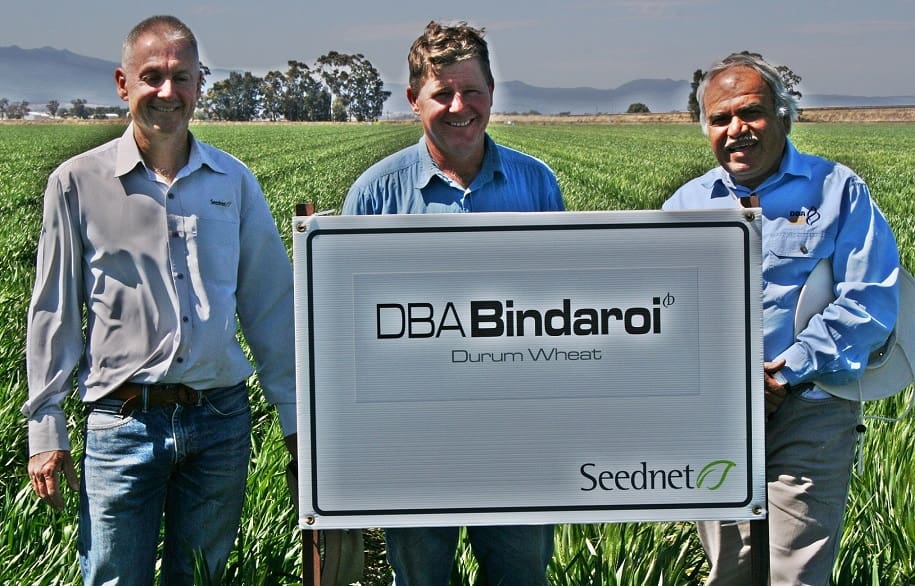
Jon Thelander (Seednet), Tony Dampney and Dr Gururaj Kadkol (NSW DPI) in the 2017 durum strip trial on Mr Dampney’s property, ‘Mirrabooka’, Narrabri.
DURUM’S premium over bread wheat of up to $100 per tonne or more has brought the specialist grain back into favour in northern New South Wales which, after three years of drought, looks set to produce an export surplus of at least 200,000 tonnes.
Supplementing this are increased areas being planted in southern Queensland and central NSW, on top of area in Victoria, South Australia and southern NSW which primarily supplies domestic pasta manufacturer San Remo.
Trade sources report one cargo of Australian new-crop durum has been booked already.
Bulk cargoes of Australian durum were last shipped in 2017, following a high-yielding year for northern NSW crops in 2016.
With yield prospects looking to be average or better for the northern crop based on full or near-full soil-moisture profiles, a 2021 export program of up to 250,000t is seen as possible.
Australian durum marketers are believed to be watching the Australian dollar, and conditions for northern hemisphere crops, to get more sales on the books.
“The North African crop has been reported as being down by 30 per cent, and we’re hearing of poor yields in Italy, and poor quality in Spain,” one trader said.
Canada, traditionally the world’s biggest durum exporter, has just finished planting its durum crop, and area is expected to be up on last year in response to China’s continued lack of interest in Canadian canola.
Canada is North Africa’s preferred supplier, but North African countries have bought top-grade DR1 Australian durum in previous years, and could be in the market in coming months.
Italy is also a potential customer for Australia.
“The biggest factor now is the dollar.”
Late swing to durum
China’s tariff on Australian barley appears to have pushed some extra paddocks into durum.
At Moree, AMPS Agribusiness agronomist Tony Lockrey said durum area had rebounded now that it was looking towards an export pathway.
“There’s as much durum in around here as we can find seed for in the area.”
Mr Lockrey said some growers were planting an extra paddock or two of durum to replace barley or chickpeas.
“It’s been a feed commodity for the past two or three years, so if it’s sitting $100/t clear of APW multigrade, that looks pretty good.”
The contract price available today for 2020-21 multigrade DR1 durum delivered to GrainCorp Moree is $342.25/t, $93.25/t above the APW multigrade price at $249/t, and $130.75/t above barley at $211.50/t.
“If you wanted to drop a paddock out of barley because of China, durum can fit in.”
Mr Lockrey said some sodden paddocks intended for chickpeas had growers fearful of the root disease, phytopthora, and opting for durum instead.
“A bit of chickpea area has gone back to durum, and area held over for summer crop has backed off too.
“Earlier this month, when durum was strong, and paddocks were three-quarters wet, it looked like barley was falling out of bed because of China, and sorghum could follow.
“It’s all put a bit more area into durum.”
At Gunnedah on the Liverpool Plains, Hunt Ag Solutions agronomist Jim Hunt said the region’s dedicated durum growers were happy to be back to full area after one or more years of drought, and occasional durum producers also had crop in.
“Durum area has increased, and that’s in response to the Chinese barley situation.
“A lot of growers flipped out of barley at the last minute.”
Risk versus premium
Durum is not an easy crop to grow.
A wet finish can spark a fusarium head blight issue that can render the grain unmarketable, and a dry finish can see the crop express crown rot, which reduces yield and quality.
Mr Hunt said these risks, coupled with limited herbicide options for black oats and ryegrass, meant the crop was not always profitable.
“A lot of committed growers are focused with their rotation, nutrition, management and weed control, but there is a production risk, and the premium growers get for durum over bread wheat has to make it worthwhile to grow.”
He said the price premium growers saw in the lead-up to planting made durum an attractive option this year.
“There was a scramble for seed at the end of the sowing window, and there are still some people sowing durum.
“There are quite a few boxes we have to tick to get DR1 — its vitreous quality, protein and colour — but even with below-average rainfall now, we’d get an average yield.
“A lot of people have jumped on the bandwagon this year, and there might be issues with quality.”
Test for new varieties
Seednet markets Bindaroi, Lillaroi and Vittaroi, all varieties bred by the NSW Department of Primary Industries at Tamworth.
Bindaroi and Lillaroi in particular have a bright golden colour which makes them attractive to domestic semolina millers and export accumulators.
They were released in 2017 and, along with AGT Westcourt which came out last year, are the most popular durum varieties in Queensland and northern NSW this year.
Vastly improved seasonal prospects for cropping areas have allowed intended and last-minute area to go into durum, and road-test Bindaroi, Lillaroi and Westcourt.
Seednet general manager Simon Crane said he thought area planted to durum in northern NSW would be similar to that of 2016, but Queensland area was up.
“This is the first year there’s been enough demand to give these new varieties a proper try.”
“Durum’s well-suited to a late planting and it’s such a quick crop, so it’s similar to barley in that way.”
Vittaroi has strong straw, which makes it suitable to grow under irrigation, and Mr Crane said its production had been “ticking over” in southern NSW since drought took hold in the state in 2017.
Grain Central: Get our free daily cropping news straight to your inbox – Click here



HAVE YOUR SAY